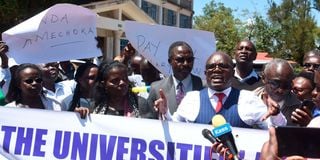
UASU Lecturers Strike
UASU Lecturers Strike in Kenya Paralyzes Public Universities: What You Need to Know
Public universities across Kenya are facing a crisis as lecturers begin a nationwide strike. The industrial action, led by the University Academic Staff Union (UASU), has disrupted learning, leaving thousands of students stranded.
Talks between the union and the government collapsed, resulting in the strike that began on September 18, 2024. The strike is centered around unmet demands for a pay rise and better working conditions, with no resolution in sight.
Nationwide Impact of the UASU Strike
The strike has brought learning to a standstill in over 35 public universities across Kenya, including major institutions like the University of Nairobi, Kenyatta University, and Moi University.
Lecturers, who have been negotiating for a salary increment and improved allowances, claim that the government has failed to honor previous agreements.
The ongoing strike not only affects students but also disrupts the academic calendar, potentially leading to a significant delay in graduation for many students.
On X (formerly Twitter), users have expressed frustration with the government for not addressing the lecturers’ grievances. Some posts are also documenting the street demonstrations held by lecturers in major cities like Nairobi, further highlighting the magnitude of the strike.
Key Players and Developments
The UASU has been vocal about the strike, demanding better pay and working conditions. According to reports from Nation Africa, the collapse of the negotiations with the government set the stage for the industrial action, which has already entered its second day.
- Citizen TV Kenya shared on X that the strike has created a crisis in universities, leaving students with no choice but to wait for a resolution.
- NTV Kenya also reported that striking lecturers took to the streets of Nairobi, holding demonstrations to pressure the government into addressing their demands.
In a statement to the press, UASU officials emphasized that the strike will continue until the government fulfills its obligations. The union accused the state of neglecting higher education by failing to allocate adequate funds for universities, resulting in poor working conditions for lecturers and non-teaching staff.
The Government’s Stance
The government, however, argues that it is working on resolving the situation. According to sources from Business Daily, the state had attempted last-minute negotiations with UASU to avert the strike, but these efforts were unsuccessful. The government’s spokesperson cited financial constraints as a reason for the delays in meeting the union’s demands but reiterated that dialogue remains open.
Social Media Reactions
The strike has sparked widespread discussions on X, where users are expressing their opinions on the matter. Some support the lecturers’ demands for better pay and working conditions, while others are concerned about the impact the strike will have on students.
- Nation Africa posted: “Learning at public varsities paralyzed as lecturers begin nationwide strike,” drawing attention to the immediate effects of the strike on students.
- Another post by NTV Kenya highlighted the striking lecturers’ street demonstrations, showing solidarity among academic staff across Kenya.
The hashtag #LecturersStrike has been trending, with students and stakeholders sharing updates and calling for swift action to resolve the crisis.
Solving the UASU lecturers’ strike in Kenya requires a multi-faceted approach that addresses the underlying issues while ensuring that both parties the government and the University Academic Staff Union (UASU) reach a mutually agreeable solution.
Here are key steps to resolve the UASU strike:
1. Reopen Negotiations
The immediate step is to reopen dialogue between the government and UASU. Both parties should be willing to compromise and come to the negotiating table with open minds. It is essential to include a neutral mediator, such as representatives from the Ministry of Labour or an independent body, to guide discussions and prevent further deadlocks.
- Action: Set a timeline for negotiations, with daily progress checks and specific targets for resolving salary disputes.
2. Address Salary and Allowances
The primary issue fueling the UASU strike is the lecturers’ demand for higher salaries and better allowances. The government needs to explore different ways of fulfilling these demands, whether by adjusting the current budget or finding alternative sources of funding for universities.
- Action: The government could consider phased salary increments over a set period to ease the financial burden while providing immediate relief to lecturers.
3. Review Working Conditions of UASU lecturers
Beyond pay, lecturers are demanding improved working conditions, including better resources for teaching and research, reduced student-to-teacher ratios, and adequate facilities in universities. The government should assess the state of university infrastructure and address these issues to enhance both teaching quality and working environments.
- Action: Form a joint task force, involving university administrators, UASU, and the Ministry of Education, to evaluate the current conditions and suggest improvements.
4. Increase Education Funding
A significant issue affecting the strike is the underfunding of public universities. The government could allocate more resources to the education sector in the national budget or explore partnerships with international education institutions and donors for additional funding.
- Action: Advocate for a larger share of the national budget for education, prioritizing universities to prevent future strikes.
5. Introduce Performance-Based Pay Models
To balance the lecturers’ demands for higher pay with the government’s concerns about financial constraints, introducing a performance-based pay system could be a viable solution. This model would reward lecturers for research output, teaching excellence, and student performance, creating incentives for better academic outcomes.
- Action: Pilot a performance-based pay system in select universities to evaluate its success before rolling it out nationwide.
6. Provide Timely Communication and Transparency
Many strikes arise due to a lack of transparent communication between government agencies and unions. The government should ensure that all parties are informed about the financial status and possible steps being taken to resolve the issues.
- Action: Schedule regular updates and progress reports through press conferences or official statements, keeping UASU lecturers, students, and the public informed.
7. Seek Short-Term Solutions for Students
To minimize disruption for students during the strike, universities can offer online classes or reschedule exams. The government should also communicate timelines for academic adjustments, ensuring that students remain engaged while the strike is ongoing.
- Action: Universities should develop contingency plans to make up for lost time once the strike is resolved, ensuring students do not fall too far behind.
8. Long-Term Policy Reforms
Beyond resolving the current strike, long-term solutions are needed to prevent future disruptions. The government should establish clear frameworks for regular reviews of university funding, salaries, and working conditions, to avoid repeated conflicts.
- Action: Set up periodic review boards that include government officials, university representatives, and UASU, ensuring that grievances are addressed before they escalate into strikes.
Resolving the UASU lecturers’ strike requires open dialogue, a commitment to addressing salary and working conditions, and a long-term strategy to improve university funding. By taking these steps, both the government and lecturers can create a more sustainable and productive educational environment.
What’s Next?
With the UASU strike ongoing and no clear resolution in sight, students are left in limbo. Universities may have to extend the academic calendar, which could cause disruptions to future intakes and graduations.
For now, all eyes are on the government and UASU to see if they can come to a resolution that will end the strike and restore normalcy in public universities.





